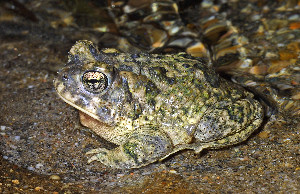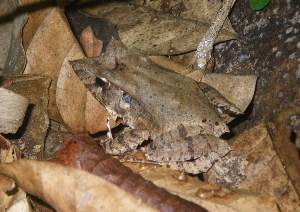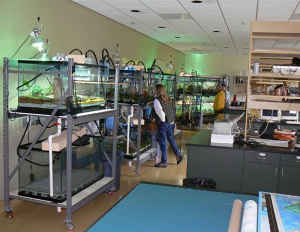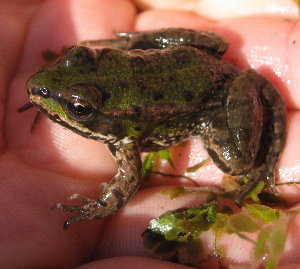Search ARMI Database
Search term(s)
Contribution Number
Search Results
874 record(s) found.
Papers & Reports Multi-scale effects of land cover and urbanization on the habitat suitability of an endangered toad.
Authors: M Treglia; A Landon; Robert N Fisher; G Kyle; L Fitzgerald
Date: 2018-11-10 | Outlet: Biological Conservation 228:310-318
Habitat degradation, entwined with land cover change, is a major driver of biodiversity loss. Effects of land cover change on species can be direct (when habitat is converted to alternative land cover types) or indirect (when land outside of the species habitat is altered). Hydrologic and ecological connections between terrestrial and aquatic systems are well understood, exemplifying how spatially disparate land cover conditions may influence aquatic habitats, but are rarely examined. We sought to quantify relative effects of land cover at two different but interacting scales on habitat suitability for the endangered arroyo toad (Anaxyrus californicus). Based on an existing distribution model for the arroyo toad and available land cover data, we estimated effects of land cover along streams and within entire watersheds on habitat suitability using structural equation modeling. Relationships between land cover and habitat suitability differed between scales, and broader, watershed-scale conditions influenced land cover along the embedded stream networks. We found anthropogenic development and forest cover at the watershed-scale negatively impacted habitat suitability, but development along stream networks was positively associated with suitability. The positive association between development along streams and habitat suitability may be attributable to increased spatial heterogeneity along urbanized streams, or related factors including policies designed to conserve riparian habitats amidst development. These findings show arroyo toad habitat is influenced by land cover across multiple scales, and can inform conservation of the species. Furthermore, our methodology can help elucidate similar dynamics with other taxa, particularly those reliant on
both terrestrial and aquatic environments.
both terrestrial and aquatic environments.
Papers & Reports Amphibians of the Pacific: natural history and conservation.
Authors: G Zug; Robert N Fisher
Date: 2018 | Outlet: in: Status of Conservation and Decline of Amphibians: Australia, New Zealand and Pacific Islands. Clayton, Vic. CSIRO Publishing.
Endemic anurans occur, with only three exceptions, on the periphery of the Pacific Basin, and only one island group, the Solomon Islands, is a "stepping stone" archipelago that, although lacking past land connections, was nearly connected to a continent or continental islands. This fauna is dominated by species within the family Ceratobatrachidae, all of which have direct development in their eggs, and lack a free living larval stage, an important life-history characteristic when living on variable island habitats where water might be greatly limited. This chapter examines the diversity of native frogs and the current environmental conditions that continue to support the persistence of frog populations and those conditions that push frog populations to local extirpation and eventually to extinction. The non-native (alien) frogs, cane toad, and the diverse anuran fauna of Guam, allow an examination of the physical and biotic environment that permits successful establishment of frogs, and the physiological and behavioural characteristics of successful, invasive species of frogs.
Papers & Reports Setting priorities for private land conservation in fire-prone landscapes: Are fire risk reduction and biodiversity conservation competing or compatible objectives?
Authors: A D Syphard; Van Butsic; Avi Bar-Massada; J E Keeley; J Tracey; Robert N Fisher
Date: 2016 | Outlet: Ecology and Society 21(3):2.
Although wildfire plays an important role in maintaining biodiversity in many ecosystems, fire management to protect human assets is often carried out by different agencies than those tasked for conserving biodiversity. In fact, fire risk reduction and biodiversity conservation are often viewed as competing objectives. Here we explored the role of management through private land conservation and asked whether we could identify private land acquisition strategies that fulfill the mutual objectives of biodiversity conservation and fire risk reduction, or whether the maximization of one objective comes at a detriment to the other. Using a fixed budget and number of homes slated for development, we simulated 20 years of housing growth under alternative conservation selection
strategies, and then projected the mean risk of fires destroying structures and the area and configuration of important habitat types in San Diego County, California, USA. We found clear differences in both fire risk projections and biodiversity impacts based on the way conservation lands are prioritized for selection, but these differences were split between two distinct groupings. If no conservation lands were purchased, or if purchases were prioritized based on cost or likelihood of development, both the projected fire risk and biodiversity impacts were much higher than if conservation lands were purchased in areas with high fire hazard or high species richness. Thus, conserving land focused on either of the two objectives resulted in nearly equivalent mutual benefits for both. These benefits not only resulted from preventing development in sensitive areas, but they were also due to the different housing patterns and arrangements that occurred as development was displaced from those areas. Although biodiversity conflicts may still arise using other fire management strategies, this study shows that mutual objectives can be attained through land-use planning in this region. These results likely generalize to any place where high species richness overlaps with hazardous wildland vegetation.
strategies, and then projected the mean risk of fires destroying structures and the area and configuration of important habitat types in San Diego County, California, USA. We found clear differences in both fire risk projections and biodiversity impacts based on the way conservation lands are prioritized for selection, but these differences were split between two distinct groupings. If no conservation lands were purchased, or if purchases were prioritized based on cost or likelihood of development, both the projected fire risk and biodiversity impacts were much higher than if conservation lands were purchased in areas with high fire hazard or high species richness. Thus, conserving land focused on either of the two objectives resulted in nearly equivalent mutual benefits for both. These benefits not only resulted from preventing development in sensitive areas, but they were also due to the different housing patterns and arrangements that occurred as development was displaced from those areas. Although biodiversity conflicts may still arise using other fire management strategies, this study shows that mutual objectives can be attained through land-use planning in this region. These results likely generalize to any place where high species richness overlaps with hazardous wildland vegetation.
Papers & Reports Mapping habitat for multiple species in the Desert Southwest.
Authors: R D Inman; K E Nussear; T C Esque; A G Vandergast; Stacie A Hathaway; D A Wood; Kelly R Barr; Robert N Fisher
Date: 2014 | Outlet: U.S. Geological Survey Open-File Report 2014-1134, pp. 92
Many utility scale renewable energy projects are currently proposed across the Mojave Ecoregion. Agencies that manage biological resources throughout this region need to understand the potential impacts of these renewable energy projects and their associated infrastructure (for example, transmission corridors, substations, access roads, etc.) on species movement, genetic exchange among
populations, and species’ abilities to adapt to changing environmental conditions. Understanding these
factors will help managers select appropriate project sites and possibly mitigate for anticipated effects of management activities. We used species distribution models to map habitat for 15 species across the Mojave Ecoregion to aid regional land-use management planning. Models were developed using a common 1 × 1 kilometer resolution with maximum entropy and generalized additive models. Occurrence data were compiled from multiple sources, including VertNet (http://vertnet.org/index.php), HerpNET (http://www.herpnet.org), and MaNIS (http://manisnet.org), as well as from internal U.S. Geological Survey databases and other biologists. Background data included 20 environmental covariates representing terrain, vegetation, and climate covariates. This report summarizes these environmental covariates and species distribution models used to predict habitat for the 15 species across the Mojave Ecoregion.
populations, and species’ abilities to adapt to changing environmental conditions. Understanding these
factors will help managers select appropriate project sites and possibly mitigate for anticipated effects of management activities. We used species distribution models to map habitat for 15 species across the Mojave Ecoregion to aid regional land-use management planning. Models were developed using a common 1 × 1 kilometer resolution with maximum entropy and generalized additive models. Occurrence data were compiled from multiple sources, including VertNet (http://vertnet.org/index.php), HerpNET (http://www.herpnet.org), and MaNIS (http://manisnet.org), as well as from internal U.S. Geological Survey databases and other biologists. Background data included 20 environmental covariates representing terrain, vegetation, and climate covariates. This report summarizes these environmental covariates and species distribution models used to predict habitat for the 15 species across the Mojave Ecoregion.
Papers & Reports Chapter D. Summary and conclusions.
Authors: R Schroeder; Elizabeth A Gallegos; G Smith; P Martin; Robert N Fisher
Date: 2015 | Outlet: U.S. Geological Survey Scientific Investigations Report pp 97-106
Hydrological and biological investigations were done during 2005 and 2006 in cooperation with the U.S. National Park Service at Darwin Falls in Death Valley National Park, Piute Spring in Mojave National Preserve, and Fortynine Palms Oasis in Joshua Tree National Park where discharge from springs or groundwater seeps sustains rare perennial streams in the otherwise arid environment of the Mojave Desert in which surface water is scarce and usually ephemeral. The study collected data on water quantity (discharge), temperature, water quality, and endemic anuran (frog and toad) populations and their health. In addition, a single survey of endemic anuran populations and their health was completed at Rattlesnake Canyon in the Joshua Tree National Park. Results from this study were compared to historical data, and can provide a baseline for future hydrological and biological investigations to evaluate health and sustainability of the resource as well as its response to changing climate and increases in human use.
Papers & Reports Chapter C. Anuran abundance and health at selected springs in the Mojave network parks.
Authors: Elizabeth A Gallegos; Robert N Fisher
Date: 2015 | Outlet: U.S. Geological Survey Scientific Investigations Report pp. 77-95
Data collected from the biological surveys completed for this study were evaluated to document the reproduction, estimate the population, and assess the overall health of each of the endemic anuran species present at the Darwin Falls, Piute Spring, and Fortynine Palms Oasis study areas. Where available, historical biological data also were evaluated.
Papers & Reports Conservation and recovery of the mountain yellow-legged frog in southern California, USA.
Authors: Adam R Backlin; Elizabeth A Gallegos; Robert N Fisher
Date: 2012 | Outlet: Global Re-introduction perspectives:2011, more case studies from around the globe, Soorae, P.S., ed. Re-introduction specialist Group and Abu Dhabi, UAE: Environment Agency-Abu Dhabi. Gland, Switzerland pp. 77-80
Papers & Reports Chapter 6. Voucher specimens: Appendix C. Field parasitology techniques for reptile surveys.
Authors: S L Gardner; Robert N Fisher; Sean J Berry
Date: 2012 | Outlet: Reptile Biodiversity: Standard Methods of Inventory and Monitoring
Studies of the systematics and ecological characteristics of hosts and their parasites require proper identification of both groups. When the parasites associated with a host are not collected
and preserved properly, species- level diagnostic characters (i.e., morphological characters) are usually destroyed. In addition, improper preservation of parasites severely limits,
or more likely prevents, studies based on DNA from those specimens.
and preserved properly, species- level diagnostic characters (i.e., morphological characters) are usually destroyed. In addition, improper preservation of parasites severely limits,
or more likely prevents, studies based on DNA from those specimens.
Papers & Reports Chapter 4. Planning and associated data: Data quality assurance and quality control.
Authors: A Atkinson; Carlton J Rochester; Robert N Fisher
Date: 2012 | Outlet: Reptile Biodiversity: Standard Methods of Inventory and Monitoring
Papers & Reports Chapter 4. Planning and associated data: Databases, metadata, and integrated data management.
Authors: Christopher W Brown; Robert N Fisher
Date: 2012 | Outlet: in: Reptile Biodiversity: Standard Methods of Inventory and Monitoring
One end goal of a study is to analyze and synthesize the data collected in an effort to understand their meaning. Most data from field studies are analyzed in an electronic format, using modern software packages for models and statistics. Consequently, how the data are stored is important and should be considered simultaneously with protocol development. Data definitions and data storage should reflect how the data are collected in the field and how they ultimately will be analyzed.
Papers & Reports Chapter 4. Planning and associated data: Handheld computers for digital data collection.
Authors: Carlton J Rochester; Robert N Fisher
Date: 2012 | Outlet: in: Reptile Biodiversity: Standard Methods of Inventory and Monitoring
Here, we describe an alternative to traditional penand-paper data recording. With recent advancements in handheld computers and their software applications, the development and use of electronic forms for recording data (using Personal Digital Assistants, or PDAs), a topic that has only been mentioned briefly in previous literature (e.g., Donnelly and Guyer 1994), has become a reality. Multiple operating platforms for PDAs, including handheld PCs, Pocket PCs, and the Palm OS (see Appendix II), are now on the market. Each one offers mobile, electronic data collection and its associated benefits to investigators in the fi eld. Below, we outline some of the advancements that have been made over the past 10 years in the use of PDAs for recording data, and we compare the benefits of recording field data electronically with those of data entry on paper sheets.
Papers & Reports Thamnophis hammondii (two-striped garter snake): Prey.
Authors: Edward L Ervin; S J Mullin; Robert N Fisher
Date: 2003 | Outlet: Herpetological Review 34(1):74-75
Papers & Reports Introduced parasites of freshwater fish in southern California, U.S.A.
Authors: B I Kuperman; V E Matey; M L Warburton; Robert N Fisher
Date: 2002 | Outlet: pp. 407-411 in: Proceedings of the 10th International Congress of Parasitology - ICOPA X. Monduzzi Editore S.p.A. - MEDIMOND Inc., Bologna, Italy. 660 pp.
Papers & Reports Thamnophis hammondii (two-striped garter snake): Prey.
Authors: Edward L Ervin; Robert N Fisher
Date: 2001 | Outlet: Herpetological Review 32(4):265-266
Papers & Reports Urban and suburban areas.
Authors: Robert N Fisher
Date: 2016 | Outlet: Habitat Management Guidelines for Amphibians and Reptiles of the Southwestern United States 154-157
Papers & Reports Chapter 2. Planning and setting objectives in field studies.
Authors: Robert N Fisher
Date: 2016
This chapter enumerates the steps required in designing and planning field studies on the ecology and conservation of reptiles, as these involve a high level of uncertainty and risk. To this end, the chapter differentiates between goals (descriptions of what one intends to accomplish) and objectives (the measurable steps required to achieve the established goals). Thus, meeting a specific goal may require many objectives. It may not be possible to define some of them until certain experiments have been conducted; often evaluations of sampling protocols are needed to increase certainty in the biological results. And if sampling locations are fixed and sampling events are repeated over time, then both study-specific covariates and sampling-specific covariates should exist. Additionally, other critical design considerations for field study include obtaining permits, as well as researching ethics and biosecurity issues.
Papers & Reports Chapter 9. Standard techniques for inventory and monitoring: Reptile sign and camera traps.
Authors: Robert N Fisher
Date: 2012 | Outlet: Reptile Biodiversity: Standard Methods of Inventory and Monitoring
Papers & Reports Chapter 9. Standard techniques for inventory and monitoring: Pitfall-trap surveys.
Authors: Robert N Fisher; Carlton J Rochester
Date: 2012 | Outlet: Reptile Biodiversity: Standard Methods of Inventory and Monitoring
Papers & Reports Chapter 3. Study design and sampling: Overview.
Authors: Robert N Fisher; M J Mitrovich
Date: 2012 | Outlet: Reptile Biodiversity: Standard Methods of Inventory and Monitoring
Papers & Reports Heterogeneous responses of temperate-zone amphibian populations to climate change complicates conservation planning
Authors: Erin Muths; Thierry C Chambert; Benedikt R Schmidt; David AW Miller; Blake R Hossack; Pierre Joly; O Grolet; David E Green; David S Pilliod; Marc Cheylan; Robert N Fisher; Rebecca M McCaffery; Michael J Adams; Wendy J Palen; Jan W Arntzen; Justin Garwood; Gary M Fellers; Jean-Marc Thirion; Aurélien Besnard; Evan HC Grant
Date: 2017-12 | Outlet: Scientific Reports. DOI:10.1038/s41598-017-17105-7
The pervasive and unabated nature of global amphibian declines suggests common demographic responses to a given driver, and quantification of major drivers and responses could inform broad-scale conservation actions. We explored the influence of climate on demographic parameters (i.e., changes in the probabilities of survival and recruitment) using 31 datasets from temperate zone amphibian populations (North America and Europe) with more than a decade of observations each. There was evidence for an influence of climate on population demographic rates, but the direction and magnitude of responses to climate drivers was highly variable among taxa and among populations within taxa. These results reveal that climate drivers interact with variation in life-history traits and population-specific attributes resulting in a diversity of responses. This heterogeneity complicates the identification of conservation ?rules of thumb? for these taxa, and supports the notion of local focus as the most effective approach to overcome global-scale conservation challenges.





